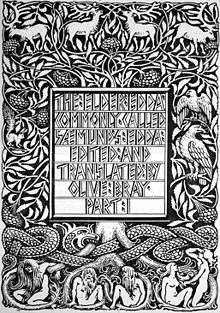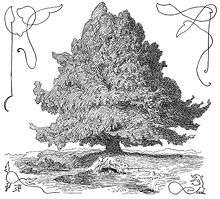Sacred trees and groves in Germanic paganism and mythology

Trees hold a particular role in Germanic paganism and Germanic mythology, both as individuals (sacred trees) and in groups (sacred groves). The central role of trees in Germanic religion is noted in the earliest written reports about the Germanic peoples, with the Roman historian Tacitus stating that Germanic cult practices took place exclusively in groves rather than temples. Scholars consider that reverence for and rites performed at individual trees are derived from the mythological role of the world tree, Yggdrasil; onomastic and some historical evidence also connects individual deities to both groves and individual trees. After Christianization, trees continue to play a significant role in the folk beliefs of the Germanic peoples.
Terminology
The pagan Germanic peoples referred to holy places by a variety of terms and many of these terms variously referred to stones, groves, and temple structures. From Proto-Germanic *xaruʒaz or *haruʒaz, a masculine noun, developed Old Norse hǫrgr meaning 'temple, idol', Old English hearg 'temple, idol', and Old High German harug meaning 'holy grove, holy stone'. According to philologist Vladimir Orel, the term was borrowed from the continental Celtic *karrikā or, alternately, the same non-Indo-European source as the Celtic source.[1] A more general term for a sacred place was *vé.[2]
The Proto-Germanic masculine noun *nemeðaz, which developed into Old Frankish nimid ('holy grove'), similarly either developed from, or is otherwise connected to, Gaulish nemeton, Latin sacellum and Old Irish nemed 'holiness'.[3][4][5]
Another Proto-Germanic masculine noun, *lauxaz or *lauhaz, has given rise to words with a variety of meanings in various Germanic languages, including Anglo-Saxon lēah, 'meadow', Middle Low German lo, 'bush', and Old High German laoh, löh, 'grove, copse, bush'; it is cognate with Latin lūcus, 'sacred grove'.[4][6][7]
Scandinavian placenames occur with the name of a deity compounded with lundr, 'grove', or viðr, 'wood'.[4]
Attestations
Sacred trees and groves are widely attested among the records of the ancient Germanic peoples. Some scholars hypothesize that they even predated the development of temples (according to Rudolf Simek, "there were sacred woods long before there were temples and altars"[8]). In his Germania, Tacitus says that the Germanic peoples "consecrate woods and groves and they apply the name of gods to that mysterious presence which they see only with the eye of devotion",[9] Tacitus describes the grove of the Semnones and refers to a castum nemus (chaste grove) in which the image of the goddess Nerthus was hallowed, and other reports from the Roman period also refer to rites held by continental Germanic tribes in groves, including the sacrifices in forest clearings of survivors by the Cherusci after their victory at the Battle of the Teutoburg Forest, recounted by Tacitus in his Annals based on a report by Germanicus.[10] Such groves were sometimes dedicated to a particular deity: in addition to the case of Nerthus, there was a silva Herculi sacra ("wood sacred to Hercules", an interpretatio romana) near the River Weser, and the Semnones reportedly held their rituals in honor of the regnator omnium deus (god the ruler of all). The scholar of Germanic religion Jan de Vries noted that placenames such as Frølund (Denmark), and Ullunda, Frösvi, and Mjärdevi (Sweden), in which the name of a deity is compounded with words meaning "grove" or "wood", suggest a continuation of the same practice, but are found almost exclusively in eastern Scandinavia; however, there is a Coill Tomair recorded near Dublin, an oak forest apparently sacred to Thor.[11] Sacred groves leave few archaeological traces, but two such sites may have been identified, both in Sweden: under the church in Frösö in Jämtland, and on a farm near Strängnäs in Södermanland.[12]
Reverence for individual trees among the Germanic peoples is a common theme in medieval Christian denunciations of backsliding into paganism.[13][14] In some cases, such as Donar's oak felled by St Boniface, these were associated with particular gods, and the association of individual trees with saints can be seen as a continuation of the tradition into modern times.[14] There is also a Scandinavian folk tradition of farmers making small offerings to a "warden tree" that is regarded as exercising a protective function over the family and land.[14] However, there are no indications that the trees were regarded in the pagan period as the abode of gods and spirits. Scholars presume that publicly revered trees such as that at the temple in Uppsala were regarded as counterparts to the mythic world tree Yggdrasil.[13][14]
Notable examples
The present section divides particularly notable examples into texts discussing the religious activities of the ancient Germanic peoples involving trees and groves (Germanic paganism) and their appearance in the myths of the Germanic peoples, particularly the North Germanic peoples (Germanic mythology).
Germanic paganism
Sacred trees and groves are mentioned throughout the history of the ancient Germanic peoples, from their earliest attestations among Roman scribes to references made by medieval monks.
| Name | Location | Description | Attestations |
|---|---|---|---|
| Grove of Baduhenna | Ancient Frisia | According to Roman senator Tacitus in his first century CE work Annals, the Frisians dismembered 900 Roman soldiers in a grove dedicated to the goddess in 28 CE. | Annals |
| Grove of Nerthus | On an "island in the ocean", often identified as Zealand, Denmark | In his first century CE ethnography of the Germanic peoples, Roman senator Tacitus describes a sacred grove dedicated to the goddess Nerthus | Germania |
| Grove of the Semnones | Possibly northern Germany | According to Tacitus, the Semnones, a populous and powerful Germanic people, allowed none to enter the grove without being fettered and blindfolded. If the blindfolded falls, they must crawl out of the grove. There they venerated what Tacitus refers to as "regnator omnium deus" and regularly gather to execute a human sacrifice. (See grove of fetters.)[15] | Germania |
| Donar's Oak | Near Hesse, Germany | Donar's Oak was a sacred tree located in an unclear location around what is now the region of Hesse, Germany. According to the 8th century Vita Bonifatii auctore Willibaldi, the Anglo-Saxon missionary Saint Boniface and his retinue cut down the tree earlier the same century. Wood from the oak was then reportedly used to build a church at the site dedicated to Saint Peter. | Vita Bonifatii auctore Willibaldi |
| Irminsul | Near Obermarsberg, Germany | Sacred pillar-like objects, perhaps tree stumps, held sacred by the pagan Saxons | Royal Frankish Annals, De miraculis sancti Alexandri, Kaiserchronik |
| Sacred tree at Uppsala | Gamla Uppsala, Sweden | According to Adam of Bremen, a huge evergreen tree stood by the Temple of Uppsala. According to Hervarar saga, it was smeared with blood after a house sacrifice was performed. | Gesta Hammaburgensis ecclesiae pontificum, Hervarar saga |
| Caill Tomair | Near Hiberno-Norse Dublin | Destroyed by Irish forces led by Brian Boru in early 1000 CE after the Battle of Glenmama (Old Irish 'Thor's Grove'). | Annals of Inisfallen |
Germanic mythology
In Norse mythology, the northernmost extension of Germanic mythology, several sacred trees are mentioned. The most prominent of these trees is the holy tree central to the cosmos, Yggdrasil.
| Name | Location | Description | Attestations |
|---|---|---|---|
| Barnstokkr | The center of King Völsung's hall | Völsung's hall is built around the tree, it bears "fair blossoms", and stretches through the roof of the structure. The tree is flanked on both sides by large hearths. | Völsunga saga |
| Glasir | In front of the doors of Valhalla (unattributed verse, Prose Edda) | A particularly beautiful tree with red-gold foliage | Poetic Edda, Prose Edda |
| Hoddmímis holt | Unstated | Future refuge of Líf and Lífþrasir during the catacylsmic events of Ragnarök | Poetic Edda, Prose Edda |
| Læraðr | On top of Valhalla | Grazed upon by the hart Eikþyrnir and the goat Heiðrún | Poetic Edda, Prose Edda |
| Mímameiðr | Central to all things, generally considered a synonym for Yggdrasil (see entry) | Cannot be hurt by fire or iron, bears fruit beneficial for pregnant women, the cock Víðópnir roosts on top of it | Fjölsvinnsmál |
| Yggdrasil | Cosmological, central to all things | An immense ash tree, central to the cosmos and considered sacred. Its branches and roots extend far into the nine worlds, and at its three roots are three wells: Urðarbrunnr, where the gods assemble daily in a thing and the three norns tend the tree, Hvergelmir, and Mímisbrunnr. Creatures live within Yggdrasil, including the dragon Níðhöggr, the squirrel Ratatoskr, an unnamed eagle, and the stags Dáinn, Dvalinn, Duneyrr and Duraþrór. | Poetic Edda, Prose Edda |
See also
- Anthropomorphic wooden cult figurines of Central and Northern Europe, wooden cult images created by the Germanic peoples
- Ask and Embla, the first human beings in Norse mythology, created from trees and whose names may mean "ash" and "elm"
- Dream of the Rood, an Old English poem describing the crucifixion of Jesus from the point of view of a sentient tree
- Ilmr, an Old Norse goddess whose name may mean 'elm'
Notes
- ↑ Orel (2003:164).
- ↑ Simek (2004:355).
- ↑ Orel (2003:284).
- 1 2 3 De Vries (1970:352).
- ↑ De Vries (1970:137).
- ↑ Orel (2003:238).
- ↑ Ringe (2006:90).
- ↑ Simek (2007:310).
- ↑ Birley (1999:42).
- ↑ De Vries (1970:351–52).
- ↑ De Vries (1970:352–53).
- ↑ Andersson (2006:195-199).
- 1 2 Simek (2007:335).
- 1 2 3 4 De Vries (1970:350–51).
- ↑ Simek (2007:280).
References
- Birley, A. R.. 1999. Trans. Tacitus, Germania. Oxford University Press. ISBN 978-0-19-283300-6
- Andersson, Gunnar. 2006. "Among trees, bones, and stones: The sacred grove at Lunda" in Andrén, Anders, Kristina Jennbert, and Catharina Raudvere. Old Norse Religion in Long-Term Perspectives: Origins, Changes, and Interactions. Nordic Academic Press. ISBN 978-91-89116-81-8
- Orel, Vladimir. 2003. A Handbook of Germanic Etymology. Brill. ISBN 9004128751
- Ringe, Donald. 2006. From Proto-Indo-European to Proto-Germanic: A Linguistic History of English, 1. Oxford University Press. ISBN 9780199284139
- Simek, Rudolf. 2007. Translated by Angela Hall. Dictionary of Northern Mythology. D.S. Brewer. ISBN 0-85991-513-1
- De Vries, Jan. 1970. Altgermanische Religionsgeschichte. Vol. 1. Grundriss der germanischen Philologie 12/I. 3rd ed (repr. 2nd ed [1956]). De Gruyter. OCLC 634541207. (in German)
Further reading
- Palm, Thede (1948). Trädkult: Studier i germansk religionshistoria. Skrifter utgivna av Vetenskaps-societeten i Lund, 33. Gleerup. OCLC 60865210. (in Swedish)

_from_Die_Helden_und_G%C3%B6tter_des_Nordens%2C_oder_Das_Buch_der_sagen.jpg)